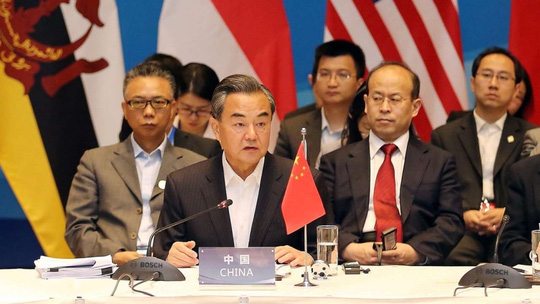|
ASEAN and the East Sea dispute
There will be no free lunch, especially in
difficult decisions. ASEAN and the East Sea (internationally known as the
South China Sea) is also a similar case.

Chinese
Foreign Minister Wang Yi speaks at the China-ASEAN Foreign Ministers' Meeting
in Yunnan.
Last August, the Association of Southeast Asian Nations
(ASEAN) celebrated the 48th anniversary.
Also during that time, the debate among scholars,
policymakers and observers, both inside and outside the region, about the
importance of this bloc to the regional security and the foreign policy of
each member country, heated up.
Referred to as the "linking forum" through
its regional mechanisms such as the ASEAN + 1's, the ASEAN Regional Forum
(ARF), and the East Asia Summit (EAS), ASEAN creates dialogue and solutions.
This connection makes ASEAN's central role in
addressing various regional issues, even the most sensitive and thorny ones.
Views on the central role of ASEAN have been challenged
in recent times, when the association seems to be increasingly drawn in many
directions by the competition between the major powers, particularly the US
and China.
This is evident in the East Sea dispute, which has more
than once challenged the solidarity and central role of this bloc.
The concern has become more clearly since early 2012,
when for the first time in the history of ASEAN, at the ASEAN Foreign
Ministers' Meeting in Cambodia, ministers could not make a joint statement.
And most recently it was the story of the "joint
statement" at the China-ASEAN Foreign Ministers' Meeting in Yunnan early
this month.
The absence of internal consensus resulted in the
situation that any updates from ASEAN on the joint statement, and a joint
declaration between ASEAN and China, were not through.
The tense situation in the East Sea has put ASEAN and
its mechanisms before opportunities as well as important challenges.
Promoting forums into a framework to enhance
predictability and transparency between countries is an idea advocated by
scholars.
Confrontations and conflicts arise when countries do
not understand clearly about the needs and intentions of others.
ASEAN could promote confidence-building and trust by
using the ASEAN Defense Ministerial Meeting Plus (ADMM+), ARF and EAS, to
encourage member states to share and discuss security and its defense
strategy, for example, standardization of action in the East Sea, or publish
the white paper on defense strategy.
Besides, while ASEAN seems to have been active in
promoting regional economic integration through agreements on free trade
negotiations with key partners, then this block should be more active in the
promote of similar initiatives on issues of security and safety of navigation
in the East Sea.
The risk in the East Sea is the direct threat to the
economic and maritime routes of the region. Therefore, these activities and
the current level of diplomatic channels 2 and 1.5 should be promoted.
That is the opinion of Ernest Bower, senior adviser of
the Southeast Asia Program at the Center for Strategic and International
Studies (CSIS).
ASEAN as a bloc and the member states sharing interests
need to invest in the change of the model of dialogue in the East Sea and
seek to promote and raise the discussion to clarify policy-level discussions
in the official forums of the region.
Dialogue is a channel to raise the issue and listen to
the views of the parties. But to turn words into action, there should be a
binding mechanism, which is a matter of ASEAN in the East Sea issue.
"ASEAN Way" has been regarded for a long time
as a peculiar way of this bloc of small and medium-sized countries to find a
mechanism to deal with the larger countries in the region.
The four factors including sovereign equality and
consensus, non-interference, informality and quiet diplomacy, and
consultation and consensus, and not using force and avoiding confrontation,
are emphasized as the main principles.
These factors on the one hand increase flexibility for
members as well as external partners but they are a barrier to important
decisions that need a strong and decisive attitude.
Mark Beeson (Murdoch University, Australia) said that
ASEAN needs to be improved politically not only for its existence through the
ASEAN Way.
In the past, regionalism in Southeast Asia was formed
in response to the hegemonic power through which to make the balance of power
between the smaller countries against larger countries.
For example, Beeson cited the case of ASEAN, the ASEAN
Regional Forum and the ASEAN + 3 as the reaction to reduce US hegemony after
the Cold War. By this time, a shift of "hegemony" has occurred and
the bloc needs a new adaptation.
If it wants something specific, then ASEAN should
understand its needs and start making clearer tests.
This bloc could be started with the issues in the form
of "soft security" as the coordination in the fields of rescue at
sea.
Or in economic issues, it can focus discussion on
capacity building in preparation for participating in the Trans-Pacific
Partnership (TPP) or favorable investment projects in the areas where the
powers outside the region are interested in and want to promote.
ASEAN should strengthen and increase the pace of the
ASEAN Economic Community (AEC) and the Regional Comprehensive Economic
Partnership (RCEP) to prevent a split within ASEAN.
Directly related to the disputes in the East Sea, ASEAN
needs to select different modes of action.
After the US-ASEAN Summit at Sunnylands, there are many
signs that the United States is increasingly supporting the central role of
ASEAN; at least it promoted the agenda towards the disputes in the East Sea
in the discussions.
This is an implicit recognition of the central role of
ASEAN in practice by emphasizing that "power politics" is not all.
Nguyen An, VNN
|
Thứ Hai, 27 tháng 6, 2016
Đăng ký:
Đăng Nhận xét (Atom)
Không có nhận xét nào:
Đăng nhận xét